By William Briggs, Statistician
The headline comes from this article at NASA. The gist of the article is “that there’s nothing to report.” Says David Hathaway:
“There have been some reports lately that Solar Minimum is lasting longer than it should. That’s not true. The ongoing lull in sunspot number is well within historic norms for the solar cycle.” Although minima are a normal aspect of the solar cycle, some observers are questioning the length of the ongoing minimum, now slogging through its 3rd year. Hathaway has studied international sunspot counts stretching all the way back to 1749 and he offers these statistics: “The average period of a solar cycle is 131 months with a standard deviation of 14 months. Decaying solar cycle 23 (the one we are experiencing now) has so far lasted 142 months well within the first standard deviation and thus not at all abnormal. The last available 13-month smoothed sunspot number was 5.70. This is bigger than 12 of the last 23 solar minimum values.” In summary, “the current minimum is not abnormally low or long.”

See larger image here.
Hathaway’s analysis starts with cycle number “1” (peaking in 1760) and ignores the previous data, which, given the extended period of low to no sunspots from 1650 to 1700, actually weakens his case. This is because, conditional on all the available evidence, periods of time with no or low sunspots are not that unusual. These quiescent periods are more likely given all the evidence than they are just using the data from 1749. This is true based on the simple observation that all the data has more quiescent periods than does the later half. It is true regardless of the periodicities or other structures present. Because we have seen periods in the past with few or no sunspots is excellent evidence, after all, that we will see these periods in the future.
So why would he purposely ignore evidence that would have strengthened his case? Part of the reason is that there is the possibility that the data before 1749 is measured with error, and so should be discounted somewhat. However, this error is not especially large. The real reason has to do with the “Maunder Minimum” (shown on the graph), the period with few or no sunspots. This period does not fit the probability model Hathaway has in mind, so it is ignored. NASA says this about the Maunder: For reasons no one understands, the sunspot cycle revived itself in the early 18th century and has carried on since with the familiar 11-year period. Because solar physicists do not understand what triggered the Maunder Minimum or exactly how it influenced Earth’s climate, they are always on the look-out for signs that it might be happening again.
But Hathaway thinks the “quiet of 2008 is not the second coming of the Maunder Minimum.” Thus we have gone from “For reasons no one understands” to “the solar cycle is progressing normally.” The path from one statement to the other is indeed rocky. This is why I believe Hathaway’s statements are too certain. See Briggs’s post and comments here.
Hathaway has been bullish on cycle 24 for a long time although has speculated on a very quiet cycle 25. See this press release from 2006. By the way we have gone today (7/16/08) 24 days without a sunspot and 73 days since the last cycle 24 spot.
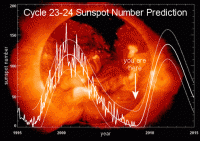
The March 2006 Hathaway forecast and the latest forecast 28 months later. See larger image here.
By Karl Bohnak, WLUC TV 6, Marquette, MI
It’s mid-summer and Lake Superior is still chilly. Mid-lake buoy temperatures usually warm up quickly from early July on. So far as of Monday, water temperatures at these buoys are barely above spring-time levels, running from the upper 30s at the northern and northeastern buoys to the low 40s at the western buoy. Over the last several years, readings ran about ten degrees or so higher at mid-July. There are likely a couple of reasons for the cold water. First, it was a chilly spring and the summer through mid-July has been close to average. Secondly over the last week, unseasonably powerful low-pressure areas have brought strong winds that have stirred up the lake, allowing upwelling of colder water to the surface. I suspect with light winds and warmer air this week surface water temperatures will begin rising quickly.
If you are a lake watcher, you have probably noticed that the water level has come up, too. As of this past Sunday, the level of Lake Superior is 601.7 feet. That’s 1.3 feet above the average of last year and less than five inches below the long-term average. Lake Superior’s level is primarily influenced by precipitation in its watershed and there has been abundant snow and rain over the last six-to-nine months.
Both the water level and water temperatures are much different than last year. This CNN story written just over a year ago, told of disturbingly low water levels and unprecedented warm water temperatures. The specter of global warming was raised in explaining these phenomenons in this story. A more level-headed report here showed how before the days of sophisticated computer models, lake observers knew there were cyclical rises and falls in the level of Lake Superior.
This year, I suspect we will not hear much about Lake Superior water temperatures or levels. “Average” or “normal” isn’t newsworthy. See Karl’s blog here.
Karl has been the main man in the TV6 Weather Center since 1988. His interests brought him to a career in broadcasting and later to the study of meteorology at the University of Wisconsin-Madison. Karl started doing TV weather in 1983. He holds the American Meteorological Society’s broadcast seal of approval and has written a book about weather and history of the Upper Peninsula of Michigan.
Theoretical physicist and mathematician Freeman Dyson on global warming in the New York Review of Books in the Wall Street Journal
Environmentalism has replaced socialism as the leading secular religion. And the ethics of environmentalism are fundamentally sound. Scientists and economists can agree with Buddhist monks and Christian activists that ruthless destruction of natural habitats is evil and careful preservation of birds and butterflies is good. The worldwide community of environmentalists—most of whom are not scientists—holds the moral high ground, and is guiding human societies toward a hopeful future.
Unfortunately, some members of the environmental movement have also adopted as an article of faith the belief that global warming is the greatest threat to the ecology of our planet. That is one reason why the arguments about global warming have become bitter and passionate. Much of the public has come to believe that anyone who is skeptical about the dangers of global warming is an enemy of the environment. The skeptics now have the difficult task of convincing the public that the opposite is true. Many of the skeptics are passionate environmentalists. They are horrified to see the obsession with global warming distracting public attention from what they see as more serious and more immediate dangers to the planet, including problems of nuclear weaponry, environmental degradation, and social injustice. Whether they turn out to be right or wrong, their arguments on these issues deserve to be heard. See the editorial here.
Freeman Dyson is now retired, having been for most of his life a professor of physics at the Institute for Advanced Study in Princeton. Dyson is a fellow of the American Physical Society, a member of the US National Academy of Sciences, and a fellow of the Royal Society of London.
By Joseph D’Aleo, CCM, Fellow, AMS
In another in an endless series of half the story articles, Livescience staff reported on the further fracturing of the Wilkins Ice sheet. “A vast shelf of ice in Antarctica is hanging on to the continent by a thread and is not expected to survive, scientists announced today. The entire Wilkins shelf, before the recent breakups, covered about 6,180 square miles (16,000 square kilometers - about the size of Northern Ireland).” (It should be noted the current total Antarctic ice extent is 13,000,000 square kilometers making Wilkins merely 0.1% of the total) and the ice is at a record extent for this time of year and appears headed to challenge or exceed last year’s record. It is mid-winter there now with 2 months more of ice growth.
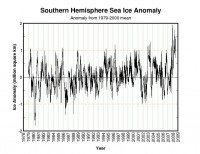
See larger image
“Wilkins Ice Shelf is the most recent in a long, and growing, list of ice shelves on the Antarctic Peninsula that are responding to the rapid warming that has occurred in this area over the last fifty years,” said David Vaughan of the British Antarctic Survey. “Current events are showing that we were being too conservative when we made the prediction in the early 1990s that Wilkins Ice Shelf would be lost within thirty years - the truth is it is going more quickly than we guessed.” This latest stage of the breakup occurred during the Southern Hemisphere’s winter, when atmospheric temperatures are at their lowest. One idea is that warmer water from the Southern Ocean is reaching the underside of the ice shelf and thinning it rapidly from underneath.
Richard Courtney, an expert peer reviewer for the Intergovernmental Panel on Climate Change who in November 1997 chaired the Plenary Session of the Climate Conference in Bonn responded “The suggested “idea” really is clutching at straws. Melting is induced by heat and fracture is induced by stress. The fractures are happening in winter. And winter is the season when temperatures are at their lowest and when ice growth is greatest. Unless there is direct evidence of the ice thinning then there is no reason to introduce any suggestion that the fracture of the ice bridge is related to higher temperatures. Indeed, the fact that the fractures are happening in the winter implies that the reverse is true: i.e. the most probable explanation is that large ice growth is providing stress to the ice bridge with resulting stress fractures of the bridge.”
By the way, UAH MSU showed among the past 30 Junes, June 2008 was the third coldest south of the Antarctic Circle. The Antarctic continent saw its third coldest June in 30 years, with temperatures averaging -1.53C cooler than the seasonal norm. Portions of Anarctica south of Australia were as much as 5.5 C (9.9 degrees Fahrenheit) colder than seasonal norms for the first month of winter. The low yesterday at the South Pole Amundsen Scott AFB was -95F.
Meanwhile at the top of the world, Livesecience repeated earlier claims that melting has become so rapid that scientists say the North Pole could be ice-free this summer.
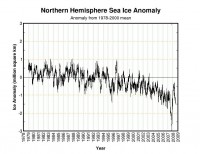
See larger image
See how the arctic is are running 1 million square kilometers ahead of last year above. Follow it daily on the University of Illinois Cryosphere here. See how the University of Colorado NSIDC which projected a 50/50 chance of full ice melt this summer shows the ice tracking this years versus last here. You will see we so far have been seeing a slower melt with a move away from the 2007 extent towards normal.
Pew Research Center for People and the Press
Amid record gas prices, public support for greater energy exploration is spiking. Compared with just a few months ago, many more Americans are giving higher priority to more energy exploration, rather than more conservation. An increasing proportion also says that developing new sources of energy - rather than protecting the environment - is the more important national priority.
The latest nationwide survey by the Pew Research Center for the People & the Press, conducted June 18-29 among 2,004 adults, also finds that half of Americans now support drilling in Alaska’s Arctic National Wildlife Refuge, up from 42% in February.
The public’s changing energy priorities are most evident in the growing percentage that views increased energy exploration - including mining and drilling, as well as the construction of new power plants - as a more important priority for energy policy than increased conservation and regulation. Nearly half (47%) now rates energy exploration as the more important priority, up from 35% in February. The proportion saying it is more important to increase energy conservation and regulation has declined by 10 points (from 55% to 45%).
Much of the increase in support for energy exploration has come among groups that previously viewed this as a less important priority than energy conservation - young people, liberals, independents, Democrats, women and people who have attended college.
Fully half of people ages 18 to 29 (51%) now say expanding energy exploration is a more important priority for energy policy than increasing energy conservation and regulation; only about a quarter of young people (26%) expressed this view in February. The proportion of liberals who say expanded energy exploration is the more important priority also has doubled (from 22% to 45%).
The gender gap in attitudes about whether greater exploration or greater conservation is the more important priority has disappeared, as women have become much more supportive of expanded exploration (up 18 points). Read more here.
More Support for Lack of Aerosols Augmenting Recent Decadal Warming
By Joseph D’Aleo, CCM, AMS Fellow
Back in November 2007, we posted a story on how volcanism affected climate, - producing global cooling after major eruptions, and a warming after lengthy quiet volcanic periods.
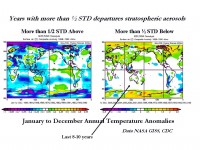
See larger maps here.
In March, we published a story about a paper by David Shiga in the New Scientist Environment Journal that supported that notion based on brightness measurements during lunar eclipses. He showed brighter eclipses in the recent decade due to cleaner atmospheres.
Now a new story in the same journal Cleaner Skies Explain Surprise Rate of Warming, Christian Ruckstuhl of the Institute for Atmospheric and Climate Science in Switzerland and colleagues took aerosol concentrations from six locations in northern Europe, measured between 1986 and 2005, and compared them with solar-radiation measurements over the same period. Aerosol concentrations dropped by up to 60 per cent over the 29-year period (actually 19 years), while solar radiation rose by around 1 watt per square metre (Geophysical Research Letters, DOI: 10.1029/2008GL034228). “The decrease in aerosols probably accounts for at least half of the warming over Europe in the last 30 years,” says Rolf Philipona, a co-author of the study at MeteoSwiss, Switzerland’s national weather service.
The latest climate models are built on the assumption that aerosols have their biggest influence by seeding natural clouds, which reflect sunlight. However, the team found that radiation dropped only slightly on cloudy days, suggesting that the main impact of aerosols is to block sunlight directly. Ironically the climate models assumed aerosols cooled the earth and created the cooling from the 1940s to 1970s. Now it appears that was wrong. The models only worked because they inserted and tweaked up the importance of the aerosol cooling in the middle of the last century. Modelers are not going to like this one. They may have to consider something radical like giving more credit to the sun or oceans.
In prior decades when pollution - particulates and hydrocarbon based haze and pollution were deemed a health problem and the goal was to develop clean burning engines and factories that only put out the natural gases - water vapor and carbon dioxide. Well we succeeded. That is until the greenhouse theory caught favor that said water vapor and carbon dioxode were bad for the planet and we have to stop at least the carbon part which was causing warming. Now suddenly much of the warming is due to the fact we cleaned up the atmosphere. Seems like the protein vs carbs vs fats good versus bad arguments played put again this time in climate.
By Chris Horner on Planet Gore
For those curious about what happened during my debate yesterday with one of the IPCC lead authors . . .
I accommodated the strange changes in our format that my interlocutor had demanded at the last minute: she insisted that I not be allowed to address the audience following her remarks. But there was still Q&A, thankfully. While not the same as a rebuttal, Q&A with an attentive group - and this was a packed house, despite two other conferences being held in Madrid yesterday - often allows the main points of contention to be aired. So a rebuttal was out - but a pre-buttal wasn’t. Knowing my counterpart’s argument from our strange encounter on the radio yesterday, I previewed some of her forthcoming unsupportable claims about Kyoto’s CDM (with a screenshot of the Guardian’s May 26 “billions wasted” headline) and alarmist SLR scenarios. I also addressed the call for spending $43 trillion on the pet project of someone on the dais (guess who?) and the sophistry of claiming that amount is “just 1 percent of world GDP.”
I can’t pin down the exact moment my counterpart lost the audience, but I think it was during the Q&A: I prefaced a remark with “my colleagues claims,” which prompted an irate outburst that “I am not Mr. Horner’s colleague!” Strange noises followed as I responded to my interlocutor’s incorrect and frankly strange insistence that Kyoto’s cap-and-trade scheme (which she claims to have birthed) “is not cap-and-trade,” and that no one actually calls it that. It was an evening of strange noises and stranger claims. Did you know that the galloping glacier Perito Moreno is disappearing from the face of the Antarctic? I didn’t have the heart to tell this native Argentinian -seriously - that it was residing comfortably in, well, Argentina. I also learned that the US SO2 trading scheme has been implemented at no cost.
I needed to explain the Pacific Decadal Oscillation to this IPCC lead author, who leans heavily on claims that Alaska is melting and who had earlier in the day demanded - on tape - to know what the PDO was. Other notable aspects of the experience included sitting next to a grown woman who persisted at crinkled lozenge wrappers (no Pez dispenser?), raked her pen back and forth across the metal spiral binder, twice clanged a metal coaster down on the dais and otherwise fidgeted like a child as I spoke. Pity soon overcame pique.
My colle- . . . counterpart had defiantly declared to the moderator prior to the event that she would not address me - ostensibly because I do not hold the Ph.D. - but only the audience (perhaps they were all Ph.D.s!). She then turned and, with feigned sincerity that could use a little work, asked what for my understandably forgotten name, drawing groans from the audience for the petulance of her display. She angrily rebutted a claim not made about her, and when challenged by the moderator about another claim she had made, denied having made it. No wonder those Kyoto confabs accomplish so little. Afterward, an audience member approached to ask how much I had paid in order to secure this person to be my opposite. A prominent lawyer sighed at the unfairness of it all and jokingly (I believe) revoked the organizer’s future participation in selecting panelists. Others remarked on how it must be nice to come from a place where it was still permissible to challenge green dogma.
Then, a wonderful dinner with a Rioja that - despite my steep bias for Ribera del Duero - was heartbreaking; the best oxtail of my life, and a general fiesta replaying these and other high points of the event with some of Spain’s finest. See link here.
By Steve McIntyre, Climate Audit
For anyone who’s betting that 2008 meltback will exceed 2007 meltback, I think that you’ll be able to pretty much know where you stand by the end of this week and your chances are not looking good right now based on this week’s exit polls. Another Climate Audit first.
The plot below shows the daily meltback for the last 5 years. 2007 is in red, 2008 in black. Notice the surge in 2007 at the end of June and beginning of July. We’re at julian day 182 today - July 2, 2008.
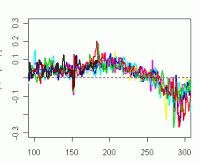
Daily melt (in million sq km). Negative numbers represent ice growth. See larger graph here
The most intense melt occurred last year between day 179 (June 29) and day 184 (July 4) with 160,000 sq km meltback on day 182 (July 2) and over 200,000 sq km on day 183 (July 3). This year is a leap year, so that July 2 is already day 182 and was only 90,000 sq km. As of yesterday, 2008 was about 510,000 sq km behind 2007 and it looks like it is losing ground day by day in the first week of July - a big melt week where it has to make time. Read more here.
Icecap Note: Steve promises more updates on Climate Audit this important week. See the side by side ice coverage from the University of Illinois Cryosphere site last year and this year (a leap year so a day earlier) here. And see the daily anomaly plot here.
See the NSIDC plot here as we fall behind 2007.
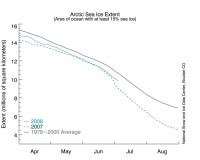
See larger graph here
Note last summer was characterized by an anomalous warm blocking high pressure on the Siberian coast. This year, there has been a cold polar trough migrating around the Arctic basin. Notice the difference in surface temperatures. Some of this offshore difference of course is due to open water last year that is still frozen this year.
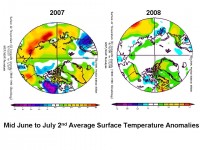
Arctic surface temperature anomalies Mid-June to July 2, 2007 vs 2008). See larger graphic here
By Dr. Kelvin Kemm, Engineering News
During 2008, have we seen many stories in the newspapers about 2007 being particularly warm as a result of global warming? During 2006, the doomsters were predicting that 2007 would be the hottest year on record, so why have we seen no reports about this? The answer is simple - 2007 turned out to be the coolest year for 30 years. It is also the case that there has been no global warming since 1998. In fact, since 1998, there has been steady cooling. Even more dramatic is the fact that the most recent computer model predictions indicate that there will be no more global warming for the next ten years. But the doomsters say that, after this ten-year period, global warming will come back with a vengeance. Why? Certainly, mankind’s production of carbon dioxide (CO2) has continued to increase since 1998 and will continue to increase, particularly since countries such as China and India say that their economic growth comes first, so they do not intend worrying too much about CO2 production. I have repeatedly pointed out that there is little or no link between CO2 production by mankind and a rise in global temperature. In fact, indications are that it is the opposite - an increased temperature causes more CO2 to be ejected into the atmosphere.
In the time of the Viking settlements on Greenland, about 1 000 years ago, there was a period of warming. That is why the Viking settlements flourished and they could grow grapes and maize, which puzzled the archaeologists. Then it cooled, and the last Viking supply ship arrived at the settlements in 1410, after which it all froze up. The world then experienced the Little Ice Age, during the time of Shakespeare and Jan van Riebeeck. The Thames froze over, and there was a period of economic decline, in comparison to the economic boom during the Medieval period of global warming. There was also an earlier warming period, known as the Roman Warming, during the period of Roman economic prosperity. All of this warming and cooling happened without any contribution from any man-made CO2.
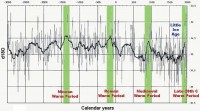
See larger image courtesy Bob Carter 2007 here.
Indications in our modern times are that the warming observed up to the end of 2006 has been due to a natural cycle in the intensity of the sun. This was, by all indications, the same source of warming of the Medieval and Roman Warming periods. But now South Africa wants to impose a carbon tax aimed at cutting South Africa’s emission of greenhouse gases. I think this is wrong. The tax, I am told, is to incentivise the use of renewable sources of power, such as wind, solar and hydro. This is crazy too. I am all in favour of wind and solar, but only if such sources can stand on their own two feet in economic competition to our coal-fired power. To fake the economics is to do damage to our exports, and to the lifestyle of every citizen. There is little or no indication that man-made CO2 is causing any climate change. There has been no global warming since 1998. The warming that did happen during the twentieth century happened mainly between 1920 and 1940. The year 2007 was the coolest year for 30 years.For us to go with the flow, or dive into a panic mode, is crazy. Let us look after the health and welfare of our people first. This does not mean being irresponsible about any sources of pollution from industrial operations or any other activities. It means using genuine science, and not the scare tactics of world political manipulators, to come to really sensible conclusions Read more here.
Dr. Kelvin Kemm, formerly a scientist at South Africa’s Atomic Energy Corporation
Harsh Winters Force Mongolian Horsemen to Abandon Nomadic LifeBy Hazel Southam, UK Telegraph
Mongolia is one of the toughest places on earth to live and can boast the coldest capital - Ulaanbaatar - on the planet. Temperatures drop to at least -30C in winter. The country is frozen from November to March. But four climactic disasters, known as ‘dzuds’, since 1999 have made life almost impossible for even the toughest of Mongolia’s nomadic people who roam over a country three times the size of France. Three particularly harsh winters since 2000 have killed a third of the nation’s livestock.
In 2001, the temperature dropped to a record-breaking -57C. Some 15,000 herders lost all of their animals through starvation and cold, and with them, their money and food. More than a quarter of the 2.6m population has left the vast rural areas, where herdsmen have lived since before Ghengis Khan’s empire was established in the 13th century, and have fled in desperation to the cities.
Among them is Byambaa Nurdev (22) a former herder in the Gobi Desert. She and her husband Tumenbayar (31) had some 600-700 sheep and goats, making them relatively wealthy. But between 2002-2005 they lost every single animal. Mongolia’s image as a land of nomadic herdsmen may be about to change for good as harsh weather conditions threaten their traditional way of life and bring more herdsmen off the land into an uncertain urban future. Read more here.
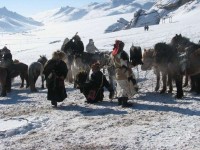
Larger image here
We may just face a planetary emergency after all—Global COOLING!
By Hazel Southam, UK Telegraph
Mongolia is one of the toughest places on earth to live and can boast the coldest capital - Ulaanbaatar - on the planet. Temperatures drop to at least -30C in winter. The country is frozen from November to March. But four climactic disasters, known as ‘dzuds’, since 1999 have made life almost impossible for even the toughest of Mongolia’s nomadic people who roam over a country three times the size of France. Three particularly harsh winters since 2000 have killed a third of the nation’s livestock.
In 2001, the temperature dropped to a record-breaking -57C. Some 15,000 herders lost all of their animals through starvation and cold, and with them, their money and food. More than a quarter of the 2.6m population has left the vast rural areas, where herdsmen have lived since before Ghengis Khan’s empire was established in the 13th century, and have fled in desperation to the cities.
Among them is Byambaa Nurdev (22) a former herder in the Gobi Desert. She and her husband Tumenbayar (31) had some 600-700 sheep and goats, making them relatively wealthy. But between 2002-2005 they lost every single animal. Mongolia’s image as a land of nomadic herdsmen may be about to change for good as harsh weather conditions threaten their traditional way of life and bring more herdsmen off the land into an uncertain urban future. Read more here.

Larger image here
We may just face a planetary emergency after all—Global COOLING!
By Chris Horner, Planet Gore
The Bret Stephens piece that Ed Craig excerpts below also brings to mind the work of Leon Festinger, whose pioneering work on cognitive dissonance theory is so applicable to a movement whose noisiest champions often lead the most incompatible lifestyles imaginable. Festinger co-wrote (with Henry W. Riecken and Stanley Schachter) the 1956 book When Prophecy Fails, which chronicled a fairly typical cult following: a housewife claimed to be receiving doomsday messages from aliens, who nonetheless offered hope for those who listened to their counsel. (Quick, someone check James Hansen’s immigration status, and bone up on the Alien Tort Claims Act climate litigation.)
Festinger et al. detailed how the failure of a prophecy to come about can often yield the opposite effect of what the rational person would expect: the cult following gets stronger and its adherents ever more convinced of their truth. One reading of Festinger, as to why the rational response should not follow in that situation, is that such prophesying is not rational, or the act of rational beings. We should not have been surprised with the current mantra, of “Cooling? Why, that’s just another sign of warming.” It is the logical next step of a movement neatly captured by Greenpeace’s Steven Guilbeault’s incantation, “Global warming can mean colder; it can mean drier; it can mean wetter; that’s what we’re dealing with.”
Beam me up.
Festinger deliciously penned the following assessment about this phenomenon: A man with a conviction is a hard man to change. Tell him you disagree and he turns away. Show him facts or figures and he questions your sources. Appeal to logic and he fails to see your point. We have all experienced the futility of trying to change a strong conviction, especially if the convinced person has some investment in his belief. We are familiar with the variety of ingenious defenses with which people protect their convictions, managing to keep them unscathed through the most devastating attacks. But man’s resourcefulness goes beyond simply protecting a belief. Suppose an individual believes something with his whole heart; suppose further that he has a commitment to this belief, that he has taken irrevocable actions because of it; finally, suppose that he is presented with evidence, unequivocal and undeniable evidence, that his belief is wrong: what will happen? The individual will frequently emerge, not only unshaken, but even more convinced of the truth of his beliefs than ever before. Indeed, he may even show a new fervor about convincing and converting other people to his view.
As a meteorologist colleague commented to me last night about a recent manifestation of precisely this, “these people are no different than the guys sitting around waiting for the spaceship.”
Chris Horner is author of “The Politically Incorrect Guide to Global Warming and Environmentalism”
See Chris’s blog here. See Wall Street Journal editorial ”Global Warming as Mass Neurosis” by Bret Stephens. See earlier Icecap Post On “Why Bringing Sanity Back on Climate Change Won’t Be Easy” here.
Questioning ScienceMainstream Media Surprise: Australian Ch. 9 TV hosts global warming debate!
The theory of anthropogenic, or man-made, global warming has become an unchallengeable fact, a piece of black letter law almost unique in the world of science. Proponents of the theory say the time for scientific debate is over. It would irresponsible to fund any further research into counter views on the relationship between elevated levels of carbon dioxide and a rise in temperatures since the mid-1970s. It’s regarded as career suicide for scientists to advocate any counter view of the causes of global warming, let alone deny the orthodox consensus view as adopted by the United Nations’ Intergovernmental Panel on Climate Change.
However, there is a school of thought that our knowledge of climate systems is as yet insufficient to be so conclusive on the causes of global warming. Today Sunday examines the political consensus building that has portrayed global warming as the most urgent crisis humankind has ever faced. Skeptics point to the gaps in the knowledge base and the flaws in the measurement of vital climate and weather data upon which the consensus is based. Social researchers also highlight the dangers of conducting science as a form of religion, divided into believers and deniers.
They warn that as governments prepare to make expensive policy decisions, such as carbon emissions trading schemes, this consensus may not reflect the best science. See this story here.
See part 1 video here. See part 2 video here. See also Andrew Bolt’s ”Warming Priests Defrocked on Sunday”.
By Patrick J. Michaels
This week marks 20 years since NASA’s James E. Hansen testified before a joint Congressional hearing that there was a strong “cause and effect” relationship between “current” climate conditions and emissions of carbon dioxide into the atmosphere. Current conditions in 1988 were a big heat wave and drought in the eastern U.S. The public bit. Two days later, 70 percent of the respondents to a CNN poll agreed with the proposition that 1988’s misery was caused by global warming. Yet in fact, no climate scientist can ever blame an individual weather event, like a heat wave or drought, on global warming.
Hansen’s testimony that year included a graph of annual temperatures, with a dramatic spike on the last point, the January-May temperatures. He knew, as does any scientist, that a sample of monthly data will vary much more than year-to-year temperatures, and that monthly data could give a false impression of extremely hot (or cold) conditions, compared to annual temperatures. Hansen has long employed stagecraft for political gain. On June 23, 1988, he delivered his testimony in an unusually toasty hearing room. Why was it so warm? As then-Sen. Tim Wirth (D., Colo.), told ABC’s Frontline: “We went in the night before and opened all the windows, I will admit, right, so that the air conditioning wasn’t working inside the room . . . it was really hot.”
Every climate scientist knows there’s been no - zero - net change in surface temperatures in the last ten years, as shown in the climate history of the United Nations Intergovernmental Panel on Climate Change. None of Hansen’s valid 1988 models predict what’s actually happened. He simply predicted too much warming, especially for the last ten years. Why should we believe what he forecasts for the rest of the 21st century?
Hansen’s 1988 predictions were flatly wrong about the extent of global warming. Yet on the 20th anniversary of his original testimony, Hansen said that people “should be tried for high crimes against humanity and nature” for spreading doubts about the promised global warming holocaust. He named names, too: the CEOs of ExxonMobil and Peabody Energy. Excuse me, Inquisitor Hansen, but what exactly are their crimes against humanity? Being demonstrably wrong about climate science?
Speaking of crimes, what about the Hatch Act, which prohibits federal employees from electioneering? In the hotly contested state of Iowa, on October 26, 2004, Hansen gave a public speech in which he stated that “John Kerry has a far better grasp than President Bush on the important issues that we face.” Kerry lost Iowa by a mere 10,000 votes. Yet Hansen persists. He recently said “the 2008 election is critical for the planet. If Americans turn out to pasture the most brontosaurian congressmen,” maybe we’ll be able to save the planet from the doom he envisions this century. Hansen also wants to tax fossil fuels, making them much more expensive than they are already. So even though he predicted too much global warming, and his numbers couldn’t explain the ten-year hiatus we’ve experienced, Hansen keeps trying to sway presidential and congressional contests. And he wants to incarcerate any CEO (or scientist, probably) who casts doubt on his vision in public.
The fact of the matter is: Hansen is out of control. NASA employees aren’t supposed to call for tax hikes, endorse candidates, or attack businessmen. Any other federal employee would be warned for doing so, and if he continued, fired (or worse). You have to hand it to him, though: he’s a single, scientific outlier, terrorizing the American people. Read more here.
Patrick J. Michaels is senior fellow in Environmental Studies at the Cato Institute.
By Brian Sussman, The American Thinker
Monday, James Hansen, Director of NASA’s Goddard Institute for Space Studies (GISS), addressed Congress and brought a new twist to his tired global warming song and dance routine. Hansen now seems to be calling for the chief executives of Big Oil to be tried for high crimes against humanity. Their crime? Spreading doubt about global warming.
Actually, it is Hansen who is guilty. Guilty of abusing the public trust. Examine the largess culled by Hansen.
In 2001, the Heinz Foundation “awarded” James Hansen with a payment of $250,000 for his work on global warming. According to the foundation: “It was Dr. Hansen who, in the sweltering, drought-scorched summer of 1988, went where few scientists were willing to go-before Congress, to explain just how serious the potential for global warming truly was.” The Heinz Foundation, directed by the wife of U.S. Senator and former presidential candidate, John Kerry, is widely known for its support of liberal causes. Is it any surprise that James Hansen also endorsed John Kerry for President in 2004? The quarter of a million was just a tease of additional monies to come.
In 2007, Hansen split a $1 million prize from the Dan David prize category of “Future Quest for Energy” (layman’s translation: a world without oil). In addition he also reported to have acted as a consultant to Gore’s global whining slide show, which was the impetus to the Prince of Peace’s film, “An Inconvenient Truth.” In fact, in 2006 Hansen had the gall to appear on a New York City stage with Mr. Gore to promote the then upcoming film-though he did reportedly inform the audience, “I’m not speaking as a government employee.”
Topping it all, Hansen has allegedly received hundreds of thousands of additional dollars to further politicize the issue of global warming. According to Investors Business Daily, “How many people, for instance, know that James Hansen, a man billed as a lonely ‘NASA whistleblower’ standing up to the mighty U.S. government, was really funded by [George] Soros’ Open Society Institute (OSI), which gave him ‘legal and media advice’? That’s right, Hansen was packaged for the media by Soros’ flagship ‘philanthropy’ by as much as $720,000, most likely under the OSI’s ‘politicization of science’ program.” Hansen denied any relationship with OSI, but Investor’s Business Daily refused to back off on their story, “claiming the funding first passed through the Government Accountability Project, which then used it to package Hansen for the media.”
With that kind of cash allegedly lining his pockets, do you think that Hansen will ever allow the data that he is charged with maintaining to point to anything but disaster? In talk-radio such conflicting activities would be deemed “payola” with the guilty party booted out the door. For the sake of truth, and the proper use of the taxpayer’s dollar, James Hansen needs to be relieved of his NASA duties. Show Mr. Hansen the door—for the sake of humanity. Read much more here.
By Joseph D’Aleo, CCM, AMS Fellow
On June 23, 1988 James Hansen, Astronomer by degree but climatologist by self appointment testified in front of congress. It was an orchestrated testimony coordinated by Senator Al Gore and a Senator from Colorado, Tim Wirth (now running Ted Turner’s UN Foundation) who admitted they picked the day after calling the National Weather Service to ensure it was a hot day. He admitted proudly later they opened all the windows the night before, making air conditioning ineffective and making sure all involved including Hansen would be seen mopping their brow for maximum effect. Hansen testified “Number one, the earth is warmer in 1988 than at any time in the history of instrumental measurements. Number two, the global warming is now large enough that we can ascribe, with a high degree of confidence, a cause-and-effect relationship to the greenhouse effect.”
See in the story below how hard Hansen has worked to try and make his prognostication verify by manipulating data. By his own comments to the UK Guardian “When you are in that kind of position, as the CEO of one the primary players who have been putting out misinformation even via organisations that affect what gets into school textbooks, then I think that’s a crime.” Well the disinformation that comprises the GISS data then by his own words is a crime, and in his own words he “should be put on trial for high crimes against humanity and nature”.
Here is the plot of actual NASA global satellite monthly temperatures since June 1988. Note the anomaly in May 2008 was lower than in June 1988 by nearly 0.3C. Of course, we don’t have June 2008 numbers yet. Please note I am not saying that cooling began in 1988. Satellites show clearly that since 1979 there was a moderate warming which peaked in 1998. A cooling has taken place the last 6 to 7 years. Global station and ocean data with all its warts shows the warming from the early 1900s to the 1930s, cooling from the 1940s to the 1970s then warming again peaking in 1998. I am just making an observation that it is ironic that 20 years after his first testimony about global warming, it is half a degree F oooler globally, not supporting the drastic measure he advocates. Also we can explain not only the trends but each spike or dip with some natural phenomena as we have shown in recent posts.
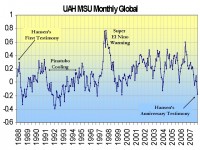
See larger image here
His testimony will no doubt include reference to upcoming or ongoing dangerous rises in sea level and ignore the data. His radio interview today on the Diane Rehm show this AM on WAMU in Washington DC, (audio links here) provides a preview of what he will tell congress.
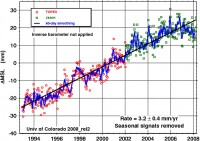
See larger image here
He will also no doubt repeat his claim he is being muzzled. He confuses a muzzle with a megaphone as shown by this table of actual Hansen media references by year (thanks to Roger Pielke Jr. on Prometheus).
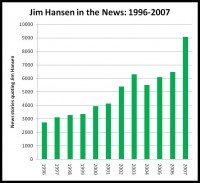
See larger image here.
Today unlike in June 1988, temperatures will be near normal in DC with temperatures in the 70s and 80s with thunderstorms. The last two weeks have averaged 2 degrees below normal. See much more on Hansen and history with this movement here.




